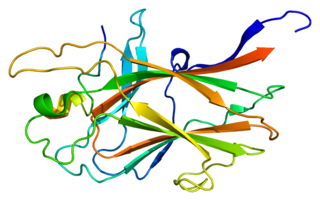
Eph receptors are a group of receptors that are activated in response to binding with Eph receptor-interacting proteins (Ephrins). Ephs form the largest known subfamily of receptor tyrosine kinases (RTKs). Both Eph receptors and their corresponding ephrin ligands are membrane-bound proteins that require direct cell-cell interactions for Eph receptor activation. Eph/ephrin signaling has been implicated in the regulation of a host of processes critical to embryonic development including axon guidance, formation of tissue boundaries, cell migration, and segmentation. Additionally, Eph/ephrin signaling has been identified to play a critical role in the maintenance of several processes during adulthood including long-term potentiation, angiogenesis, and stem cell differentiation and cancer.

Ephrin-B2 is a protein that in humans is encoded by the EFNB2 gene.

Ephrin B1 is a protein that in humans is encoded by the EFNB1 gene. It is a member of the ephrin family. The encoded protein is a type I membrane protein and a ligand of Eph-related receptor tyrosine kinases. It may play a role in cell adhesion and function in the development or maintenance of the nervous system.

EPH receptor A2 is a protein that in humans is encoded by the EPHA2 gene.

Ephrin type-B receptor 4 is a protein that in humans is encoded by the EPHB4 gene.

Ephrin A1 is a protein that in humans is encoded by the EFNA1 gene.

EPH receptor A4 is a protein that in humans is encoded by the EPHA4 gene.

Ephrin type-B receptor 1 is a protein that in humans is encoded by the EPHB1 gene.

EPH receptor A3 is a protein that in humans is encoded by the EPHA3 gene.

Ephrin type-B receptor 6 is a protein that in humans is encoded by the EPHB6 gene.

Ephrin type-A receptor 8 is a protein that in humans is encoded by the EPHA8 gene.

Ephrin type-A receptor 7 is a protein that in humans is encoded by the EPHA7 gene.

EPH receptor A5 is a protein that in humans is encoded by the EPHA5 gene.

Ephrin-A2 is a protein that in humans is encoded by the EFNA2 gene.

Ephrin A3 is a protein that in humans is encoded by the EFNA3 gene.

Ephrin-B3 is a protein that in humans is encoded by the EFNB3 gene.

EPH receptor A1 is a protein that in humans is encoded by the EPHA1 gene.

Ephrin type-B receptor 3 is a protein that in humans is encoded by the EPHB3 gene.

Ephrin type-A receptor 6 is a protein that in humans is encoded by the EPHA6 gene.

Ephrin A5 is a protein that in humans is encoded by the EFNA5 gene.























